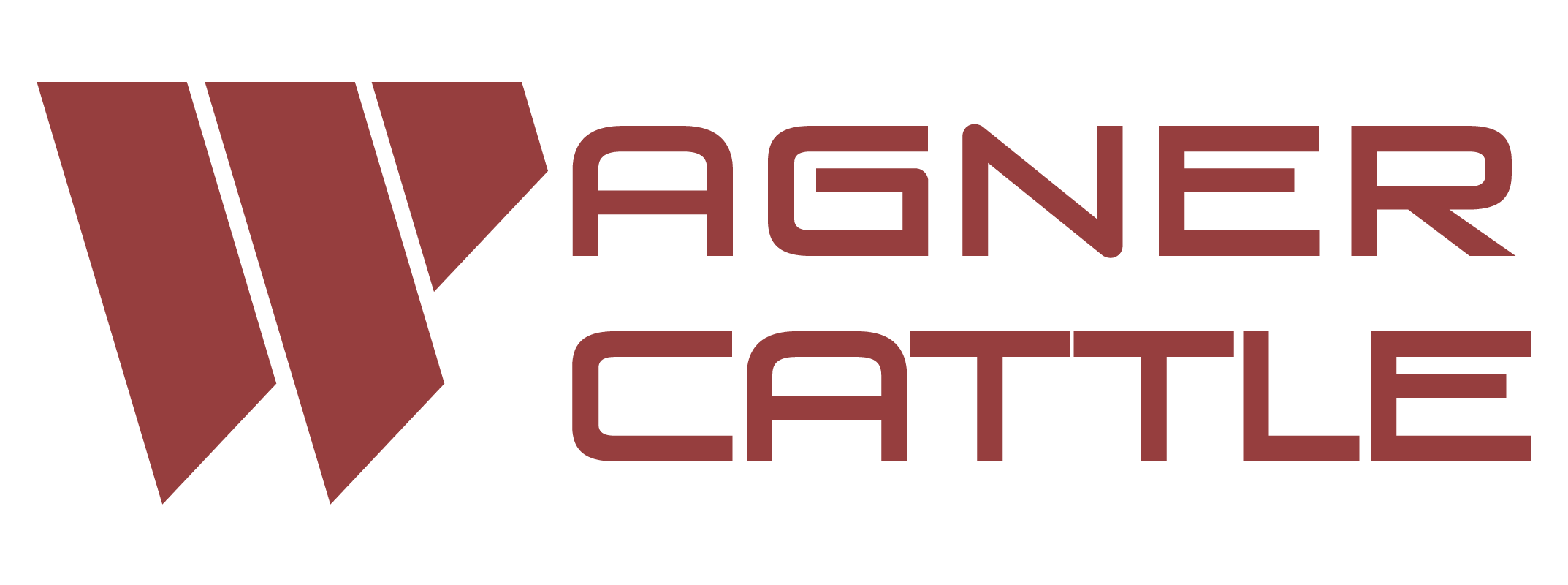How We Raise Beef
Purebred
At Wagner Cattle, we utilize three breeds of cattle: Purebred Black Angus, Purebred Black South Devon, and Purebred Black Simmental.
These three breeds have been chosen for their specific traits, and how they excel in the “REAL WORLD." Our COMPOSITE LINES are made up of two or three of the breeds, combining strong traits designed to maximize heterosis (growth-vigor-health and performance).
First, we decide which bulls produce the best offspring and which cows they are best paired with. Then, we decide which pure lines to breed together, depending on demand. Then, we make it happen, delivering a well-rounded bull or heifer that can go to work on any farm or ranch and improve producers’ bottom lines.
Calving
We have two calving seasons, spring and fall. The cows raise the calves on pastures on both sides of the Mississippi River, and have access to fresh water and a constant supply of free choice vitamins and minerals.
When the calves are approximately seven months old, we begin weaning and vaccinating them, under the supervision of a veterinarian. Simultaneously, we begin to acclimate the calves to feed rations designed by our nutritionist to supply ample vitamins and minerals. Then, we begin to increase the feed intake for the bulls.
Growing Phase & Nutritional Intake
The growing phase is about 90 days in length, during which cattle weighing 600 to 850 pounds are fed an optimal protein, low starch diet to facilitate muscle and frame development in preparation for moving them into the finishing phase, described below.
Diets are formulated by Wagner Cattle’s nutritionist from carefully
chosen ingredients, proportioned to create the right protein:calorie ratio. Feeding management and performance are closely monitored, and necessary adjustments are made in the diets as the growing phase progresses. Ingredient quality is monitored to assure that the diet specifications are being met and to prevent feeding anything that may contain spoilage or adulterants.
Diets are fortified with vitamins and minerals to:
- Enhance immunity
- Assist the cattle in the digestion of expensive protein and energy ingredients
- Provide antioxidants important to muscle and connective tissue integrity
- Enhance muscle hydration and accentuate muscle bloom
- Maintain rumen (the major digestive organ) health, which in turn creates efficiency in the way cattle convert feed into beef
Although the primary target during the growing phase is to create muscle,
a small portion of the calories consumed begin to find purpose in the deposition of intramuscular fat. This is a key element in creating a satisfactory eating experience for our customers.
Learn More About Beef Nutrition
Finishing Phase
When cattle approach 850 pounds, they are gradually transitioned onto a lower protein, higher starch diet, to speed up the deposition of intramuscular fat (known as marbling) and regulate the deposition of fat cover (external carcass fat). Again, the purpose of this transition phase, which is intentionally slow and deliberate, is to protect rumen health. Pretty much all of the principles of ingredient quality, diet formulation and feeding management used in the growing phase are similarly used during finishing. But, keep in mind that dietary starch is a much more important component in finishing cattle than in growing cattle if a satisfactory beef eating experience is to be achieved.
As cattle selected to become Wagner Beef approach the endpoint of the finishing phase (about 130 days beyond the end of the growing phase), their proximity to making the best possible product is measured using ultrasound, similar to the procedure used in the practice of human medicine. As deposition of finish progresses, it becomes increasingly important that creature comforts are provided, heat or cold stress is controlled, muscle hydration is maintained, and shelf appeal (beef color and texture) is created. These are all facilitated through diet manipulation, but with the well-being of the cattle in mind.
Ultrasound
We measure the daily gains of the cattle, and, at about twelve months of age, we use ultrasound to measure the size of the rib eye, the marbling in the rib eye, the rib fat, rump fat, and back fat. We collect data on numerous traits that are important to producers, putting them into numbers and ratios. We also do a breeding soundness exam, and a semen sample is taken to guarantee a fertile and sound bull.
At this point we have collected all the important genetic data, and the bulls are sold to farmers and ranchers or sent for processing. The bulls are selected by producers for their traits and breed and go on to produce cattle on their own farms and ranches. This same process takes place at our customers’ operations; the resulting cattle are moved to the feedlot (see growing phase below) and, at approximately 900 pounds, are again scanned via ultrasound to select for high marbling.
The finished cattle are then moved to our USDA inspected beef processing facility, where they are carefully and humanely processed.
Dry Aging
Our beef is dry aged for 31-41 days. This long aging process gives a better flavor and increases tenderness for a consistent delicious product.
Our beef is then cut and immediately frozen at very cold temperatures which locks in the freshness and flavor without the use of preservatives. The cuts are vacuum sealed which maintains this freshness for up to one year or longer without any additional cost to our consumer.
